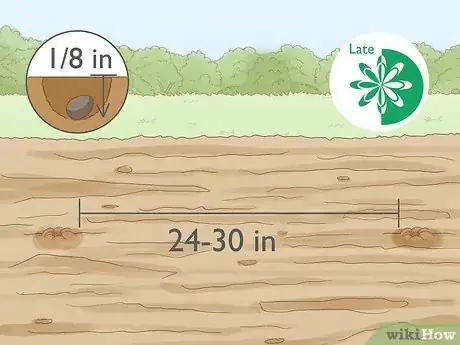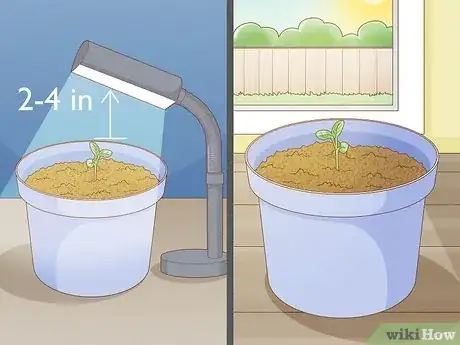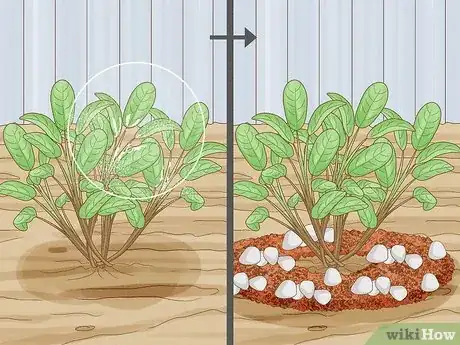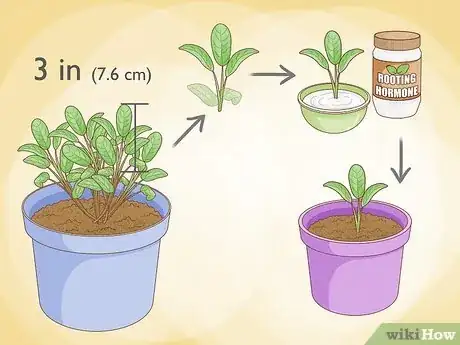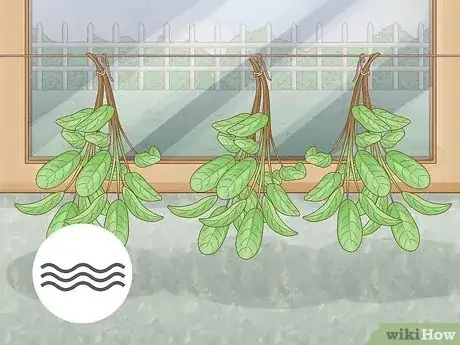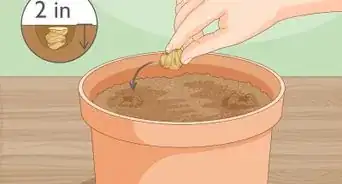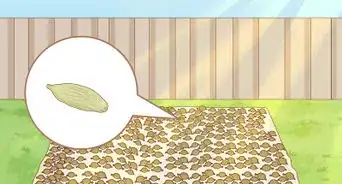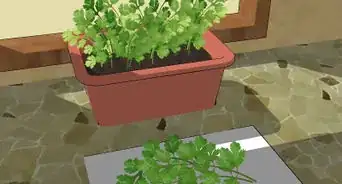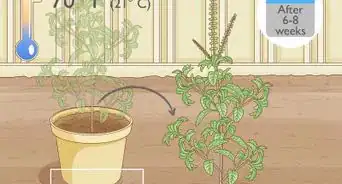This article was co-authored by Andrew Carberry, MPH. Andrew Carberry is a Food Systems Expert and the Senior Program Associate at the Wallace Centere at Winrock International in Little Rock, Arkansas. He has worked in food systems since 2008 and has experience working on farm-to-school projects, food safety programs, and working with local and state coalitions in Arkansas. He is a graduate of the College of William and Mary and holds a Masters degree in public health and nutrition from the University of Tennessee.
wikiHow marks an article as reader-approved once it receives enough positive feedback. This article has 11 testimonials from our readers, earning it our reader-approved status.
This article has been viewed 252,966 times.
Sage (Salvia officinalis) is a hardy perennial (in zones 5 to 9) that tastes aromatic and slightly bitter. It is easy to grow, only having three major requirements - plenty of sunshine, good drainage and good air circulation. Sage grows well in a variety of climates, and it can survive in temperatures as low as zero degrees Fahrenheit. It looks pleasant in the garden and grows pretty purple, pink, blue or white flowers in summer. When harvested and dried, it can be used as a stuffing for poultry, rabbit, pork, and baked fish, and can also be used in sausage or meat loaves. Learn how to grow sage so that you will always have some on hand.
Steps
Growing Sage
-
1Buy sage seeds or a sage plant. You can begin growing sage using several methods. If you've never had sage before, you can either plant fresh sage seeds (which can be temperamental) or purchase a small plant from the garden center and transplant it into your garden or a clay pot.
- However, if you already have an established sage plant, you can use cuttings or layering techniques to grow a new plant.
-
2Prepare the soil. Sage grows well in rich clay loam that drains well and is rich in nitrogen. It prefers soil with a pH of 6.0 to 6.5.
- If you're using clay soil, try mixing in some sand and organic matter. This lightens the soil and helps with drainage.
- Sage grows best when it is planted with other perennial herbs, such as thyme, oregano, marjoram and parsley.
Advertisement -
3Plant the sage. After prepping your soil, you can plant the sage either in pots or in the ground. You can either plant sage plants or plant seeds.
- If you are transferring a sage plant into the ground, then make sure to plant it at the same level as it was in the pot.
- If you decide to plant seeds, they should be planted in late spring (in a bed or in a container) about 1/8 inch deep and 24 to 30 inches apart. They will take 10 to 21 days to germinate.
-
4Go easy with watering. When the sage plants are small, you should mist them with water to keep the soil moist.
- But when they reach maturity, you should only water sage when the soil surrounding the plant is dry to the touch.
- In fact, in some climates you won't need to water your sage at all - they'll get all the moisture they need from rainfall.
- Sage is a tough little plant and is very drought-tolerant.
-
5Provide adequate sunlight. Ideally, sage plants should grow in full sun, but they will also survive in light shade in hotter areas.
- If sage is exposed to too much shade, it will grow leggy and flop over. So if you keep your sage plant in an indoor area without much sunlight, you can use fluorescent lights instead. Standard fluorescent lamps should be 2 - 4 inches above the plants.
- However, high output fluorescent, compact fluorescent, or high intensity discharge (metal halide or high pressure sodium) plant growing lights work better and, if used, should be placed 2–4 feet (0.6–1.2 m) about the plants.
Maintaining Sage
-
1Prune the sage in early spring. Prune the older, woodier stems in early spring, after the danger of freezing is past but before new growth has really begun. Prune each stem by about a third.
-
2Prevent mildew. Mildew is one of the only problems sage-growers have to deal with. You can avoid it by watching the plants carefully during hot, humid weather and by thinning the plants regularly to increase air circulation.
- You can also try mulching the earth around the plant with pebbles, as this helps any moisture to evaporate more quickly.
- If mildew does develop on you plant, try spritzing it with a horticultural oil or sulfur spray.
-
3Control pests. Sage is usually not a target for pests, but sometimes it will be affected by spider mites, thrips, and Spittlebugs. If you notice any pests, try using an organic pesticide (like pyrethrum) or an insecticidal soap to keep them under control.
-
4Replace the plant every three to five years. After about three to five years, the sage plant will become woody and straggly and will need to be replaced. You can either start again with a new plant or seed, or use the old plant for cuttings or layering.
- To layer the plant, bend a branch of the existing sage towards the soil. Use some wire to pin the branch to the ground, about 4 inches from the tip. After about four weeks, roots will begin to form. Then you can cut the branch and transplant the newly formed sage plant to another location.
- To use cuttings, cut the top 3 inches from the branch of an existing sage plant. Strip the lower leaves from the stem, or use a scissors to cut them off. Dip the ends in rooting hormone, then place in sterile sand. Wait 4 to 6 weeks for roots to form, then move to a pot and later the garden. It is best to take cuttings of plants in early spring, just after you notice some new growth.
Harvesting Sage
-
1Harvest the sage. Harvest the sage lightly during the first year, picking off leaves as you need them.
- In subsequent years, you can harvest the sage year round by cutting entire stems from the plant. Sage is considered to be at its best just before the flowers bloom, usually in mid-summer.
- Do your last full harvest approximately two months before the first major frost of the year. This gives any newly formed foliage enough time to mature before winter sets in.
-
2Dry the sage. Sage is one of the few herbs that develops a stronger flavor when dried. However, it needs to be dried quickly to avoid developing a musty taste.
- To dry sage, tie a bunch of sprigs together and hang them upside down in a warm, well-ventilated location away from direct sunlight.
- Once they are dry, store the leaves (crumbled or whole) in an airtight container.
-
3Use the sage. In addition to being used as an aromatic herb in cooking, sage can also be used in potpourri and soap. Here are some things you can do with sage:
- Make Parmesan and Sage Biscuits
- Make a Violet and Sage Cold Sore Cream
- Make Oatmeal and Sage Soap
- Make Sage and Ginger Tea
Expert Q&A
Did you know you can get premium answers for this article?
Unlock premium answers by supporting wikiHow
-
QuestionWhen is the best time to transplant purple sage?
 Andrew Carberry, MPHAndrew Carberry is a Food Systems Expert and the Senior Program Associate at the Wallace Centere at Winrock International in Little Rock, Arkansas. He has worked in food systems since 2008 and has experience working on farm-to-school projects, food safety programs, and working with local and state coalitions in Arkansas. He is a graduate of the College of William and Mary and holds a Masters degree in public health and nutrition from the University of Tennessee.
Andrew Carberry, MPHAndrew Carberry is a Food Systems Expert and the Senior Program Associate at the Wallace Centere at Winrock International in Little Rock, Arkansas. He has worked in food systems since 2008 and has experience working on farm-to-school projects, food safety programs, and working with local and state coalitions in Arkansas. He is a graduate of the College of William and Mary and holds a Masters degree in public health and nutrition from the University of Tennessee.
Food Systems Expert
-
QuestionDo you trim off purple flowers?
 Andrew Carberry, MPHAndrew Carberry is a Food Systems Expert and the Senior Program Associate at the Wallace Centere at Winrock International in Little Rock, Arkansas. He has worked in food systems since 2008 and has experience working on farm-to-school projects, food safety programs, and working with local and state coalitions in Arkansas. He is a graduate of the College of William and Mary and holds a Masters degree in public health and nutrition from the University of Tennessee.
Andrew Carberry, MPHAndrew Carberry is a Food Systems Expert and the Senior Program Associate at the Wallace Centere at Winrock International in Little Rock, Arkansas. He has worked in food systems since 2008 and has experience working on farm-to-school projects, food safety programs, and working with local and state coalitions in Arkansas. He is a graduate of the College of William and Mary and holds a Masters degree in public health and nutrition from the University of Tennessee.
Food Systems Expert
-
QuestionWhen should I fertilize sage?
 wikiHow Staff EditorThis answer was written by one of our trained team of researchers who validated it for accuracy and comprehensiveness.
wikiHow Staff EditorThis answer was written by one of our trained team of researchers who validated it for accuracy and comprehensiveness.
Staff Answer wikiHow Staff EditorStaff Answer
wikiHow Staff EditorStaff Answer
Warnings
- Be careful when using pesticides if you are going to eat the sage.⧼thumbs_response⧽
References
About This Article
Sage can be dried and used as a spice in many different types of recipes. It’s easy to grow and just needs sunlight, good drainage, and air circulation. To grow sage, plant sage seeds in a large clay pot. Alternatively, you can purchase a small sage plant from your local garden center and transfer it to a pot. Once it’s planted, mist it with water only enough to keep the soil moist, since sage needs very little water. You’ll want to place the sage in a spot with full sun, or else it may grow limp and flop over. Once the leaves grow large enough, you can snip them off and dry them out for future use. To learn how to prune your sage, read on!


